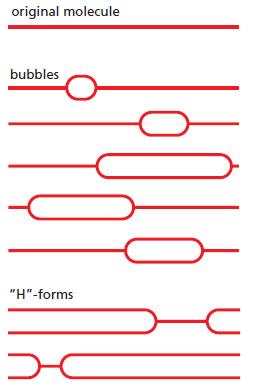The laboratory you joined is studying the life cycle of an animal virus that uses circular, double-strand
Question:
The laboratory you joined is studying the life cycle of an animal virus that uses circular, double-strand DNA as its genome. Your project is to define the location of the origin(s) of replication and to determine whether replication proceeds in one or both directions away from an origin (unidirectional or bidirectional replication). To accomplish your goal, you broke open cells infected with the virus, isolated replicating viral genomes, cleaved them with a restriction nuclease that cuts the genome at only one site to produce a linear molecule from the circle, and examined the resulting molecules in the electron microscope.
Some of the molecules you observed are illustrated schematically in Figure Q5–1. Note that it is impossible to distinguish the orientation of one DNA molecule relative to another in the electron microscope. You must present your conclusions to the rest of the lab tomorrow. How will you answer the two questions your advisor posed for you? Is there a single, unique origin of replication or several origins? Is replication unidirectional or bidirectional?
Figure Q5–1

Step by Step Answer:

Molecular Biology Of The Cell
ISBN: 9780815344322
6th Edition
Authors: Bruce Alberts, Alexander D. Johnson, Julian Lewis, David Morgan, Martin Raff, Keith Roberts, Peter Walter




